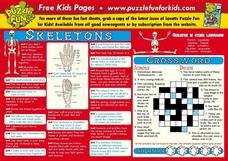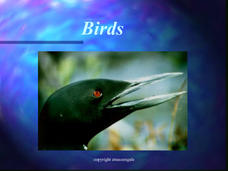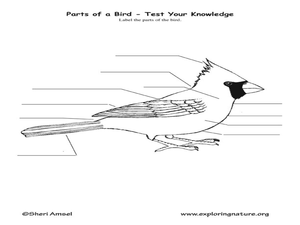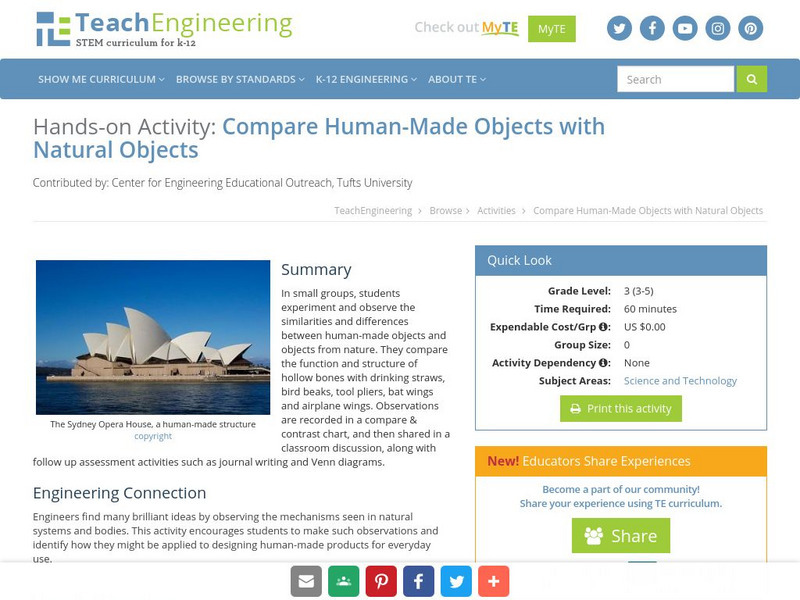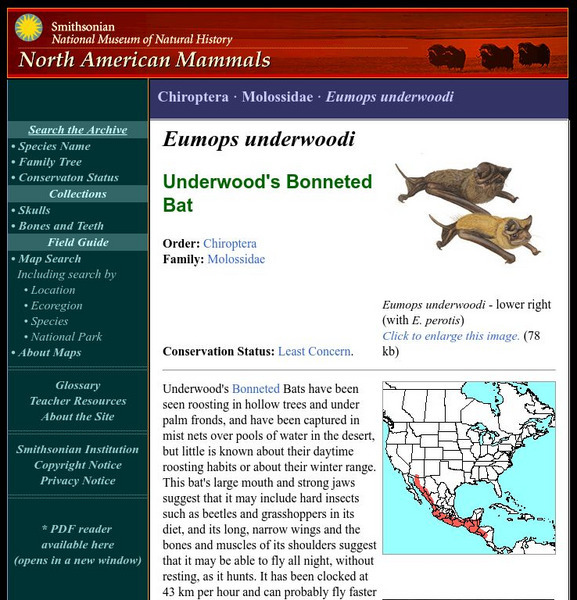BioEd Online
Bone Structure: Hollow vs. Solid
What is meant by the phrase "form follows function?" Allow your budding biologists to discover first-hand through two activities. In the first, groups work together to discover whether a solid cylinder or an empty cylinder can support...
Curated OER
Bones, Bones, and More Bones
Students describe the functions of bones in the human body. They describe the make up of a bone. They engage in a series of wonderful hands-on activitiies that reinforce learning of bones and the skeletal system.
Curated OER
Bones
Fifth graders observe real bones and models to learn about the structure and function of the skeletal system. In this skeletal system lesson plan, 5th graders manipulate objects and models of bones. They handle real bones and determine...
Curated OER
Compare Human-made Objects with Natural Objects
Students examine and observe how many human-made objects get their basic design from things in nature. They listen to the book "Nature Got There First," compare/contrast hollow bones with drinking straws, bird beaks and tool pliers, and...
Curated OER
Skeletal System (Continued)
Students examine human bones. For this skeletal system lesson, students review the functions and locations of bones in the human body. Students work in groups to complete an activity where they discover why bones are hollow and discuss...
Curated OER
Skeletons
In this science worksheet, students investigate the human skeletal system. Students read factual paragraphs with details about the bones in the human body and in some other species as well. Students complete a crossword puzzle.
Curated OER
The Name Game
In this science worksheet, students select 24 of the dinosaur names from the list and write them in the spaces on the bingo card. They match each of the dinosaurs listed to their correct description.
Biology Junction
Birds
Birds adapted to almost every climate on the planet, from the Arctic to the rain forests. A presentation focused on birds covers their similarities and differences. It starts with their evolution from reptiles, their many physical...
Curated OER
All About Birds
In this birds learning exercise, students answer 25 short answer questions about birds. They color and label the different parts of a bird and fill in the correct term given the definitions.
Curated OER
Investigation 9 - Bird Study
Fourth graders examine specific bird characteristics and become more aware of the ecosystems that support each bird. They engage in bird walks, mapping the areas where they find evidence of bird activity.
Curated OER
ACTIVITY 6: MAKE A FOSSIL MOLD AND CAST and ACTIVITY 7: HOW BIG WERE PREHISTORIC ANIMALS?
Instructions for two terrific ancient history lessons for your primary paleontologists are provided in this resource. The first involves the creation of fossil cast replicas using plaster of Paris. The directions are detailed, but the...
Curated OER
Verterbrate Classification
Students are introduced to the broad categories of vertebrates including fish, amphibians, reptiles, birds and mammals. They identify the characteristics of each group and then view slideshows and video of example species.
Curated OER
Adaptations
Students identify what adaptation is and to research a specific mollusk. They also identify and interpret how animals get their common and scientific name and why it is Latin. Finally, students draw their shell (mollusk) and name their...
Curated OER
Birds
In this birds worksheet, students review the characteristics of birds including their adaptations for flight. Students review the diversity of bird adaptations. This worksheet has 4 short answer, 7 true or false, 6 matching, and 3 fill...
Curated OER
Quiz: Birds
In this science worksheet, 3rd graders will focus on various birds. Students will respond to ten true/false questions all pertaining to birds.
Curated OER
What is a bird?
Students sort birds by their physical characteristics. In this bird characteristics lesson, students review bird characteristics and create beaks. Students discuss birds as pets.
Curated OER
Learning Bird Traits
Students draw and label a bird. In this bird traits lesson, students learn what traits make a bird different from other animals. Students are taught how to draw a bird and are expected to label the various body parts they drew.
Curated OER
Comparing Human and Avian Skeletons
In this human and avian skeleton review worksheet, students read about both skeletal systems and respond to 10 fill in the blank and drawing questions.
Curated OER
Respiration Crossword
For this respiration worksheet, students complete a crossword puzzle by figuring out the vocabulary words associated with the 14 clues given.
Curated OER
Birds of Wisconsin
First graders explore the job done by ornithologists. They role play identifying the characteristics that make a bird a bird. They discuss what makes each bird species unique. Students are introduced to Wisconsin's most common and rare...
Curated OER
Make Sense of Nature
Students participate in this program that heightens their awareness and curiosity of nature as well as their sense of adventure and exploring new surroundings. They identify and choose an object from nature after exploring it with other...
TeachEngineering
Teach Engineering: Compare Human Made Objects With Natural Objects
In small groups, students will experiment and observe the similarities and differences between human-made objects and nature. The students will compare the function and structure of hollow bones with drinking straws, bird beaks, tool...
Smithsonian Institution
National Museum of Natural History: American Mammals: Underwood's Mastiff Bat
Underwood's mastiff bats have been seen roosting in hollow trees and under palm fronds, and have been captured in mist nets over pools of water in the desert, but little is known about their daytime roosting habits or about their winter...







